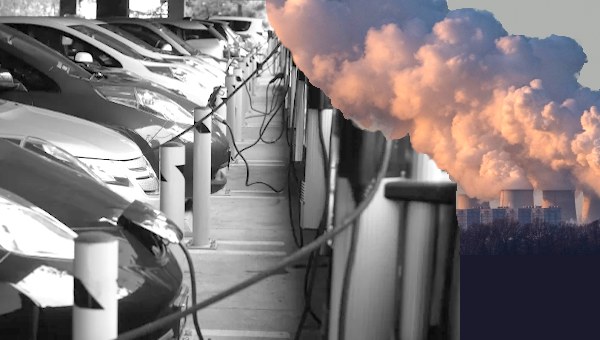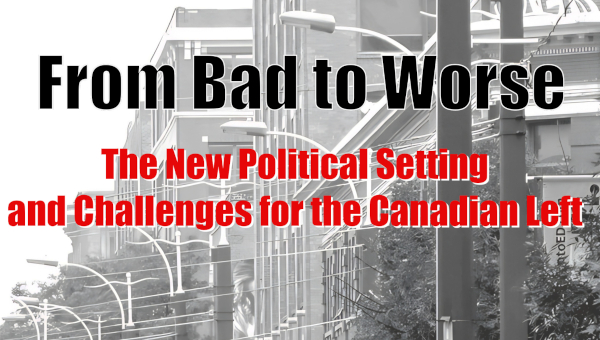‘So Far from God, so Close to the United States’: Responding to Biden’s Buy-American Auto Rebates
The recently passed US “Build Back Better Act” includes a section that is causing great angst for America’s co-signers of the US-Mexico-Canada Trade Agreement (USMCA).* Justified as addressing the environmental crisis as well as jobs, the US legislation provides for rebates on electric vehicles sold in the US – but only if the vehicles are also produced in the US.
Though this move is inseparable from the American nationalism that Trump both responded to and nurtured, Biden’s stance can’t be reduced to an echo of Trump’s “Make America Great.” Unlike Trump, Biden’s plan acknowledges and responds to both the environment and the need to support unionization. In any case, Canadian progressives have themselves often argued that it is eminently sensible to link government-paid rebates to domestic job protection and creation.
Yet given how overwhelmingly dependent the Canadian and Mexican motor vehicle industries are on the US market, they could be devastated by this latest Buy-American gambit. For Chrystia Freeland, Canada’s Finance Minister and Deputy Prime Minister, this step “risks becoming the dominant bilateral issue between the two countries.”

Rebates for Electric Vehicles
In essence, the rebates work as follows. Effective on the full passing of the bill, there will be a $7,500 subsidy to purchasers of electric vehicles no matter where they are made. But as of 2027 the $7,500 subsidy will only apply to vehicles made in the US. An additional subsidy of $4,500 will be added if – in a remarkably concrete affirmation of Biden’s support for organized labour – the vehicles are made in unionized plants. This would raise the potential subsidy to $12,000. (It is not clear whether the measure of ‘unionization’ applies only to assembly plants or to the parts that go into the assembly.)
The tensions Freeland raises revolve on whether the US action contravenes the trade agreement that Canada and Mexico supported in great part precisely to block the US acting unilaterally. But far more needs unpacking here. Are vehicle rebates the best way to accelerate the shift away from fossil fuels? Is vehicle electrification as central to solving the environmental crisis as the hype suggests? Is preserving the current trade agreement the answer to the dilemma Canada faces in responding to the US policy? What can Canada do if the US won’t reverse or modify its position? And is the provocative pro-union step taken by Biden unambiguously positive?
It is possible that given the interests of the US-based auto majors in protecting their recent and planned Canadian investments and their options in choosing suppliers, the US may accommodate Canada and Mexico this time. But the tensions are another reminder of our power imbalance with the US and our vulnerability, trade agreement or not, to US interests and priorities as circumstances in the US shift economically or politically.
Is this vulnerability to be accepted on ‘practical’ grounds or should we, as Toronto Star columnist Thomas Walkom has suggested, treat this latest assertion of American unilateralism power as not just a threat but an opening? Why not build on it to begin easing our gnawing overdependence on the US? Why not counter by declaring a parallel ‘Buy Canada’ program?
Rebates
It is useful to start the discussion leading to Walkom’s question with a review of the US rebate program. Government rebates on electrical vehicles are not themselves new in North America. In 2016, the provincial Liberals introduced an even higher rebate of $14,000 in Ontario, Canada’s largest province and the center of auto production. However, in mid-2018, when the Ontario liberals were replaced by the Conservatives, this was cancelled. The Federal Liberals countered with new rebates in 2019 of $2,500 for hybrids, $5,000 for fully electric vehicles – far less than the original provincial plan. Quebec, at $8,000, currently has the highest provincial rebate; with the federal rebate, this rises to as much as $13,000.
In a matter of days after the US rebate plan was passed, and in the early days of a coming election in Ontario, the provincial Liberals followed suit, proposing rebates on the purchase of electrical vehicles that matched those of Quebec. The NDP and Greens declared their own programs were in the works. (The Conservatives were unrepentant; Ford opted instead to build more highways and pave over large tracts of a current Greenbelt.)
But what is especially significant in these reactions by Canadian provincial and federal politicians is that none of them have so far gone in the direction Biden has. In none of them is there any linking of rebates to the question of domestic investment and jobs, never mind the presence of a union.
In all these US and Canadian cases, the mandated rebates are paid for by the government, that is, the taxpayer, not by the auto companies. This is so despite the prime responsibility the industry bears for its detrimental role in addressing the environmental crisis. Even now, as GM proudly advertises itself as environmentally conscious, it is doing its damnedest to sell fuel-guzzling, high-profit trucks before conversion to electric vehicles can no longer be avoided.
Rebates focus on market incentives to the consumer and coddle the auto giants. Why not instead, or even in addition, address the supply side and directly set ‘targets’ – establish a date after which fossil-fuel-based internal combustion engines are banned? The relevant example here is that on January 1, 1942, the US War Production Board issued an emergency presidential order to ban auto production within a month so that auto facilities and materials could be converted to the overwhelming priority at the time: military production.
The ban, despite with some grumbling by business, was remarkably smooth and successful: Stalin himself (then a US ally) noted that without the US turn to military production “we would have lost the war.” A similar transformational initiative should be, at least technically, no harder, and likely easier, today, given technological and institutional advances since then.
If the environmental crisis is anywhere as serious as scientists are frantically telling us, and as floods and fires have forced skeptics and politicians to increasingly acknowledge, then why cannot the political will be organized and mobilized to take the decisive actions taken the last time the threat was anywhere close to the global threat faced today? Why is the response to this emergency still so muted?
Electrification
Yet in discussing rebates on electric vehicles, a prior question can’t be avoided. To what extent is the electrification of private motor vehicles the answer to escaping our current self-destructive trajectory? The public attention to electric vehicles is a welcome indicator of a growing awareness that ‘something must be done’. And the turn away from internal combustion engine is a positive step forward. But the contribution of electric vehicles as the definitive ‘fix’ to the environmental crisis is exaggerated, and often reflects a complacent desire to continue our lives much as before – something no longer possible.
The limits of electric vehicles in terms of range and access to charging stations are likely to be overcome. More worrisome is that the batteries used in electrical vehicles themselves pose serious environmental concerns in the mining, manufacturing, and recycling of the materials (especially lithium and cobalt). And if all we do is replace one kind of car with another, not interrupting the expansion of our car culture, then the environmental pressures will still be aggravated by the energy used in the making of these additional vehicles.
The point is not that motor vehicles will disappear from our roads, but rather, that a radical shift in the balance of transport away from privately owned has become essential. Free public transit must become as taken for granted as free sidewalks. Our roads should increasingly be occupied by both electric vehicles providing other necessary public services (postal vans, utility vehicles, delivery vans, ambulances, minibuses) and a more sustainable use of electric cars through car-sharing (as with bike stations) and municipally owned uber-type electric taxis to supplement public transit.
Above all, discussing electric vehicles must not divert us from the larger social issues posed by the massive scale of the environmental threat. Consider just two examples: the relationship between environmental constraints and inequality, and between environmental planning and private control over investment.
The extent of inequality in capitalist societies is itself a blight. But environmental constraints add a further dimension. In the past, inequalities were muted by growth; growth held out the promise of everyone getting more, even if unequally so. But if the calling card of the future necessitates limits to material growth, the excessive consumption and luxuries of the rich become more clearly exposed as coming at the expense of the many.
Inequality, then, merges with the environmental crisis, and the inequities formerly tolerated are increasingly seen as intolerable. Greater equality becomes a condition for any general acceptance of restraints on individual consumption.
Similarly, when the goal of individual consumption predominated, it could be argued (within limits, of course) that private corporations competing for private profits effectively answered those desires. But if future well-being and survival now necessitate a significant shift from individual consumer goods to greater weight for equality and collective goods and services (healthcare, education, care for the aged, free transit, music and culture events, etc.), and if, as well, addressing the scale of the environmental crisis needs planning in the social interest, then the private property rights of corporations become a principal barrier to restructuring society in an environmentally sensitive way.
What is, therefore, challenged by the above examples is not just a policy but capitalism itself.
Buy Canada?
As the federal Liberals, reinforced by the critical support of Unifor, double down on the trade agreement, some history is relevant. Through the 1980s and 1990s, unions – and especially the Canadian auto union – fought against such trade agreements. What they grasped but now seems lost was that trade agreements were not aimed to protect the jobs of workers, but rather, the property rights of corporations. The ‘freedom’ that the free trade agreements primarily defended was the freedom of corporations to act in the interests of maximizing their profits without consideration of the social impacts.
These agreements locked in the corporate rights – constitutionalized them – so no future government might reverse them. In the particular case of such agreements with the US, critics understood the obvious: the agreements would not, given the imbalance in power favoring the US, be so binding, especially as economic and political circumstances evolved. Hence the on-going unease in Canada with trade agreements with the Americans.
The limits of the USMCA were clear from the very beginning, even as the Liberals and Unifor president Jerry Dias hailed the agreement as giving workers a new level of security. The agreement was signed on October 1, 2018; some six weeks later, GM abruptly announced that GM Oshawa, along with several US plants, would close. GM was comfortable that doing so was allowed by the trade agreement, calling to mind GM’s promise in 2016 to keep Oshawa running at least through 2020 in exchange for concessions and its subsequent claim – which the union didn’t legally challenge – that the collective agreement did not block this move. (In mid-2019, GM reversed its decision, but that had nothing to do with the FTA – it was the result of changed market conditions and relative capacities in various North American plants.)
It may be that doubling down on the USMCA will lead to some accommodations to the US Build Better Act. For one, the Biden administration was likely not so much targeting Canada and Mexico as it was absorbed with the chaos of American politics and ignoring the repercussion of the Act on its ‘partners’. Moreover, the US auto majors, who had recently announced some significant investments in Canada, will themselves want to protect those investments and prefer not to radically reorganize their supply chains, which would involve importing more components from the US to pass the value threshold (likely 50%) for being considered ‘American made’.
Yet that wouldn’t end the vulnerability of Canada’s auto industry or prevent pressures on Canada should we want to move in directions not to the liking of the US. It’s that which makes so prescient Walkom’s call to think beyond begging for mercy, and instead, start a discussion on countering the Buy-American policy with our own Canadian program.
There is, however, a catch to a Buy-Canadian policy focussed on the auto industry. Though it might serve one or possibly two assembly plants, the reality is that the Canadian industry is not large enough to offset the loss of the US car market. The alternative is, therefore, far more complex. It would be necessary to reach beyond auto to convert/diversify existing machinery and skills in the sector to other social uses.
This is where taking the environment seriously comes in. If the environmental crisis means transforming everything about how we work, travel, and live – everything – and accomplishing this will require all kinds of material goods, then why are we not resolutely moving to plan for this now? It is not business-oriented trade agreements that we need, but rather, the planned use of our skills and productive capacities to meet the most pressing needs we face.
Since you cannot plan what you don’t control, it would mean fundamentally challenging corporations, including, as Green Jobs Oshawa has convincingly argued, seconding productive facilities to serving social needs, not profits (as should have happened during the pandemic). Raising this and the extension of public ownership would, of course, involve significant risks and uncertainties. Yet if the environmental crisis is truly an existential crisis requiring previously unimagined steps, continuing to stumble along with the status quo is the greatest danger of all.
Pro-Union
Finally, what of the intriguing and radical aspect of the rebates being linked to unionization? As a gesture to unions, this is an impressive step towards legitimating the centrality of unions. Offering higher rebates for vehicles that are union-made essentially argues that unions are a social good that that should be supported. The message is that transition to a Green Economy must also be a just transition and amongst other things, this demands the democratic counter-voice of working people through their unions.
No other American president or Canadian prime minister or other head of state has ever gone this far. In Canada, the federal Liberals, who spend a great deal of their efforts on brandishing their alleged progressive credentials, especially relative to the US, signed an agreement with Amazon to effectively be the supplier of choice to the Canadian state during the pandemic. In contrast to Biden, it never occurred to them (or was rejected if it did) to prove their mettle by making this conditional on introducing exemplary health and safety standards and opening the door to an unrestricted union organizing drive.
It needs noting that this part of the Biden bill may still not see the light of day (it has yet to pass the US Senate). Republicans will fight against it, not just in principle, but to protect the non-union, largely Asian and European auto plants in their constituencies. They will also be aware that the presence of unions in southern US communities tends to become a base of support for the Democratic Party. In addition, many Democrats, already unhappy with much of the overall Act, will also be ready to dump the unionization clause as part of further compromises in the Bill.
But even leaving this aside, we need to dig deeper here as well. The weakness of the American labour movement extends far beyond low union density. After all, they once had higher union density, yet this didn’t prevent them from suffering their profound defeats. Moreover, Canadian unions have two to three times the density of US unions, yet Canadians would be hard pressed to argue that the Canadian labour movement is today a more dynamic, leading social force than their US counterparts.
The problems of the American labour movement reside in their inability, through recent decades, to transform themselves in light of new circumstances and aggressive new attacks on their institutions and members. Their problems reside as much in their failures to organize the already organized, as in bringing non-union plants into the fold.
Resolving this from the top down, though a crucial signal of support, will not correct this dilemma. It may even postpone getting at the transformations needed and leave the door more open to them being reversed, a story with precedents in other measures favourable to working people. And if the potential power that unionization brings is offset by an intensified emphasis on international competitiveness – as the Biden Bill decidedly does throughout – then the space for union gains in bargaining and looking to expanded social gains will be narrowed even as union institutions grow in size.
The point is not to denigrate Biden’s support for working people, but rather, to suggest that the main issue is not ‘granting’ workers a union but removing the very considerable barriers to workers making democratic decisions that belong to them without corporate involvement of any kind.
Better to extend the positive steps in the Pro Act bill and argue that since corporations have access to workers by virtue of their role in the workplace, even without captive meetings, unions too should have access to the workforce: access to the workers that will be involved in the decision on unionization (just as political parties routinely get access to voters’ lists) and access to in-plant space for collective meetings to explain unions to workers and answer their questions. And if the union way is the right way, then why limit this to auto? Why not give workers everywhere the de facto freedom to choose how they are represented?
Summary and Conclusion
The electrification of the auto industry is much in the air today. A little over a hundred years ago (1920), Lenin famously described communism as “Soviet Power plus electrification of the whole country.” What is so interesting about this formulation is that it links both the social and technical in revolutionary advance. For us, too, ‘electrification’ is increasingly presented as the gateway to a new future. But with no revolution yet on the horizon, electrification tends to be reduced to a technical fix for preserving lifestyles and class relationships that, as science and nature are desperately screaming out, our planet can no longer afford.
The move to electric vehicles has a progressive role to play but has tended to be oversold as the ‘solution’ to the environment crisis. As such, it diverts us from the true challenge of what must be done. The crisis of the environment is inseparable from the world of obscene inequalities, lives of permanent insecurity, and the thin democracy that leaves our present and future in the hands of private corporations competing for profits. Attending to the environment is inseparable from coping with capitalism.
Avoiding such questions in the name of being ‘practical’ is, at this stage of the world, the least practical thing we can do. Closing our eyes to reality guarantees more of the same, and more of the same means an inevitable disaster. There is only one alternative: thinking bigger and more radically and daring to risk in the name of another future. •




